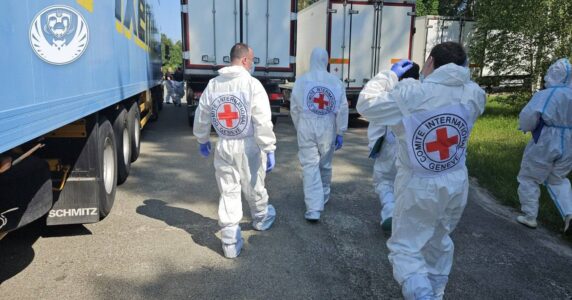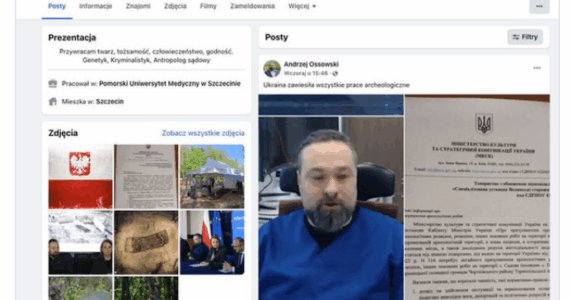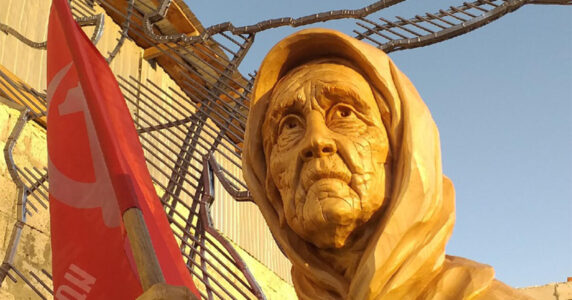Navigation and useful materials
Konashenkov is creating an “information balance,” and the Kremlin is stubbornly waiting for the Third World War. The Centre for Strategic Communication and Information Security has collected the main fakes and narratives of the Russian propaganda of August 1.
- Russian MoD is “destroying” HIMARS for Buryat grandmas
- Putin as a stand-in for Alexander Nevsky
- Moscow desperately waiting for a do-over of World War III
- Ending the myth of Russian landing assault forces
Russian MoD is “destroying” HIMARS for Buryat grandmas
If HIMARS did not exist, Russian propagandists would have to invent it. They need something to fight against — in their daily “high precision creative mode.” The futile information strikes on the colony in Olenivka were barely over, and then on August 1, the propagandists “destroyed” a few more American MLRS, which were allegedly located on the second floor of Kharkiv plant Ukrainian Energy Machines, according to their “creative” minds.
Reporting this lie, the speaker of the Russian MoD Konashenkov specified that they also “destroyed 53 Ukrainian nationalists and foreign mercenaries.” He shared “video evidence.”
IN REALITY, two more episodes are missing from this military drama that he invented. In the first, he should have shown how “Ukrainian nationalists” drag two MLRS with a total weight of 22 tons to the second floor of the plant (where the offices are mainly located). The second one would feature the “high-precision strike” itself. And in the third final episode they should have shown Konashenkov walking around the Kharkiv plant and counting the number of destroyed “nationalists” and, additionally, “foreign mercenaries.” But Konashenkov is in Moscow. It’s probably easier to count from there.
The speaker of the Russian MoD has been “fighting” for over five months, but he hasn’t learned anything. But it’s hardly surprising. He is not telling these stories to the General Staff, but rather to a random Buryat grandma whose grandson will soon go to Ukraine.
If Ukrainian Minister of Defence Reznikov reports on August 1 that we have received 4 more HIMARS systems, Konashenkov must report on their destruction on the same day. It was reported that MLRS MARS II have arrived from Germany. Therefore, Konashenkov will “destroy” them soon as well.
His task is just to keep a basic count: something has arrived, and this something has been “destroyed.”
Putin as a stand-in for Alexander Nevsky
After what the occupiers did to the Orthodox shrines in Ukraine, some romantically hoped for the sanity of the Patriarch of the Russian Orthodox Church Kirill. People hoped that he would at least shy away from preaching for Putin’s bloodthirsty values. Maybe at least in prayers he would call for the end of the war. Right? Wrong. The patriarch himself led the Putinist herd.
Explaining the purpose of the war in Ukraine, he said that “our brothers and sisters in the Donbas may suffer for their loyalty to the Church.”
IN REALITY, Gundyayev just broadcast the official Kremlin narratives. Before that, he may well have participated in their development himself.
On August 1, it came to light that the Kremlin had developed a new handbook explaining how the Russian propaganda must speak about the war in Ukraine. In this handbook, the “special operation” must be compared to the baptism of Kyivan Rus, and Putin — to Alexander Nevsky.
The invasion into Ukraine is explained by the actions of “the collective West, which has been attacking Russia for almost a thousand years now, to divide it and obtain its resources, and to destroy the Orthodox faith.”
One of the goals of the “special operation” is “the fight against the godless,” characterized as “rapists, robbers, and murderers,” who “did not believe in anything and believed themselves to thus be exempt from any moral obligations to other people.”
They propose to designate the Ukrainian military as “the godless,” too. Propagandists are advised to say that they “make sacrifices and commit ritual murders.”
“There is no morality for Ukrainian Nazis, they do not think in such categories and are really godless. They are not afraid of God’s punishment for their crimes. Many of the Ukrainian Nazis are open Satanists and followers of misanthropic cults,” assures the Russian Presidential Administration.
(A good occasion to remember famous stories of Russian propaganda, from black magic for mortar operators to “the satanic temple of the Right Sector”.)
There is also an interesting story about Alexander Nevsky and the “collective West”. Turns out, the latter should be understood (at different points in history) as: The Teutonic Order, Sweden, the Commonwealth of Poland and Lithuania, the Napoleonic Empire, the Third Reich and NATO.
The Kremlin notes that now the West (as before) wants to destroy Russia in order to seize resources: “the consumer society that has developed in the West requires a lot of resources. The West ran out of its own resources several centuries ago. This became the cause of colonialism and neocolonialism. The West directly says that Russia has too many resources for one country, and therefore it should be divided.”
These arguments are supposed to lead the readers and viewers to the idea that the war in Ukraine is “Russia’s preventive strike”: “The leadership of the country and Putin himself prevented an attack on Russia. A decision was made to start the special military operation, which made it possible to avoid a repeat of June 22, 1941 with the invasion of Nazi troops on the territory of Russia.”
However, the manual says, all Western attacks end the same way: “Society unites around a national leader and, demonstrating courage and heroism on the battlefield, repels the invaders.” The Kremlin “recommends” to note that this happened both after the victory in the Battle of Neva and after the start of the war in Ukraine. That is, Putin is compared to Alexander Nevsky.
The latter is an ambiguous figure — he regularly went to pay homage to the Khan of the Horde and brought tribute for the right to rule. So the Kremlin may want to reconsider its metaphors.
Moscow desperately waiting for a do-over of World War III
On August 1, Russia ordered society to wait for the official start of the Third World War. It should symbolically start with the Balkans. The conflict between Kosovo and Serbia was fuelled by Russian media to the fullest. They reported on every minute detail non-stop. A big uproar was caused by the use of the term “denazification” by one of the Serbian politicians.
The address of the President of Serbia Vučić was broadcast almost live. They were waiting, of course, for the announcement of a “special operation.” The expectation was accompanied by a call to “nations offended by the West to join the CSTO.“
They even went so far as to list what weapons Moscow and Beijing provided to Belgrade, comparing combat capabilities of Kosovo and Serbia, and even a warning: “Moscow will not directly engage in the conflict, but will support Belgrade.”
The support was justified in a rather old-fashioned way — the need to protect the Orthodox Serbian people. Hello 19th century!
IN REALITY, everything ended rather simply. “The West” suggested that Pristina postpone the resolution of the disputed issue (new entry rules to Kosovo for Serbs) for a month. An agreement was reached. Moscow never got a “Balkan remake of the beginning of the First World War,” as they called it.
It is clear what the Kremlin wanted. An escalation in the Balkans would force the US to spend its forces and resources on the Kosovo conflict, which would hurt Ukraine.
But this is a local story. The Kremlin’s goal has remained unchanged for decades: to benefit from somebody else’s problems.
As before (since the First World War, which led to the collapse of Tsarist Russia), the Kremlin stubbornly tries to fuel the fire: “from the taiga to the British seas.”
When it didn’t work out with Serbia, the Russian media immediately switched to the other side of the world, reporting live about the “beginning of the Third World” in Taiwan, where speaker of the US House of Representatives Nancy Pelosi was flying.
Ending the myth of Russian landing assault forces
And while Ms. Pelosi is flying, Russia recalled its attack on the Priština airport ahead of its sacred day of Russian landing assault forces. On June 12, 1999, Russian paratroopers occupied the Slatina airport in the capital of Kosovo before the NATO forces did. Why? Nobody understands it until this day.
This operation had no tactical or strategic significance and only showed the savagery of the Russians, who cannot and do not want to work within the framework of a single peacekeeping operation. Even Russian historical resources call it “pointless and unnecessary.”
IN REALITY, things have got much worse for the Russian paratroopers since then. And the war in Ukraine proved it. Russia is actually discussing whether they need landing assault troops in the form in which they exist today.
We remind you that the 34th Special Forces Airborne Brigade, which tried to capture Hostomel airfield on the first day of the invasion live, was later entirely destroyed by Ukrainian defenders.
Russia endeavored to hold on to the myth about the heroic paratroopers who entered into an unequal battle with the “neo-Nazis” and held on to the last, giving their lives for the motherland. Then it turned out that the rest of Putin’s “winged infantry” in Ukraine were no more lucky than the mythical “Hostomel Spartans.”
Among the identified losses of the Russian army, 20% are paratroopers (714 people). Of course, the real losses among dead and wounded are much, much higher.
After the February defeat in Hostomel, Russian paratroopers are used as motorized infantry in Ukraine. And therefore, they die like infantry does. Here is a small chronicle of the fatal fall of Putin’s “winged infantry” in Ukraine:
- In March, 55 paratroopers of the 247th Airborne Assault Regiment were killed.
- At the beginning of April, 60 elite Pskov paratroopers refused to participate in the war.
- On April 20, Putin replaced the commander of the 76th Airborne Assault Division. Parts of the unit took part in the battles near Bucha, losing at least 18 people (according to open sources). Soldiers may be involved in war crimes.
- On May 22, a unit of the 76th Airborne Assault Division was destroyed, at least 14 people were killed.
- On May 26, almost an entire company of the Tula 106th Airborne Division was destroyed in the Donetsk oblast.
- At the end of May, 129 soldiers of the 108th Airborne Assault Regiment refused to go and fight in Ukraine.
- In July, a number of units of the 106th and 76th Airborne Divisions were sent home due to a large number of refusals to participate in hostilities in Ukraine.
- On July 13, the Armed Forces of Ukraine attacked the command post of the 106th Airborne Division. 28 invaders, including the command staff, were killed or wounded.
- On July 25, an attack was made on the 11th Airborne Assault Brigade from Buryatia near Kherson. The headquarters ended up destroyed.
- On July 28, the commander of the Kostroma 331st Parachute Regiment, Pozdeyev, was killed.
Thus:
– The 45,000-strong airborne troops of the Russian Federation lost several thousand of the most trained and combat-capable fighters in Ukraine. The other units have lost manpower and equipment.
– The Airborne Forces of Russia proved to be rather archaic in nature. While the Armed Forces of Ukraine already have a good arsenal of air defence systems, including mobile ones (Igla, Stinger, and others), the much-overhyped Putin’s airborne troops suffer critical losses before they even land. As a result, after staggering losses in the first weeks, the command of the Russian Federation refused to use paratroopers “for their actual purpose.”
– The replacement of Air Force Commander Serdyukov with Teplinsky (as well as other urgent rotations of military leaders) shows that the failure of his own army in Ukraine has already become obvious to Putin.
But public recognition would be detrimental to him. Therefore, until the end of the war, there will be attempts to maintain the reputation of the Airborne Troops with media stories.
But the truth is out there.
Ukraine has defeated Putin’s “invincible” paratroopers. And the entire world already knows.
If you have found a spelling error, please, notify us by selecting that text and pressing Ctrl+Enter.


